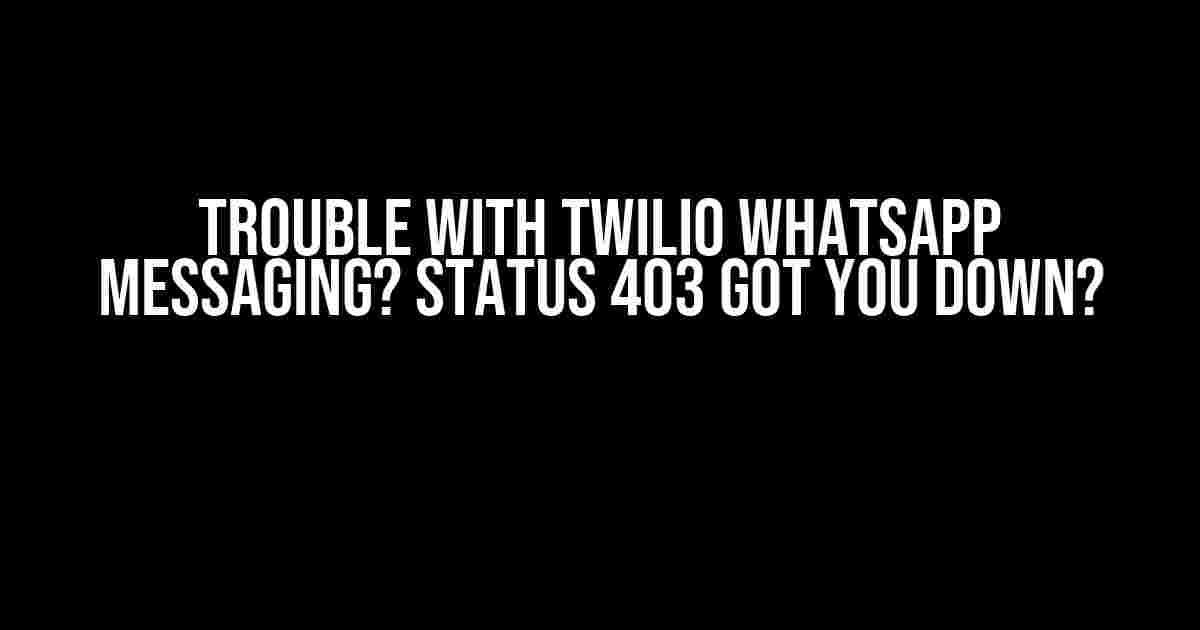Are you struggling to get your Twilio WhatsApp messaging up and running, only to be met with a frustrating status 403 error? Don’t worry, friend, you’re not alone! In this article, we’ll dive deep into the world of Twilio WhatsApp messaging and help you troubleshoot that pesky status 403 error.
What is Status 403, Exactly?
Before we dive into the troubleshooting process, let’s take a quick look at what status 403 actually means. Status 403 is an HTTP error code that indicates “Forbidden.” In the context of Twilio WhatsApp messaging, this error code typically means that your request is being blocked by WhatsApp due to some kind of authentication or permission issue.
Why Am I Getting a Status 403 Error?
There are several reasons why you might be getting a status 403 error with your Twilio WhatsApp messaging. Here are some common culprits:
- Invalid or Expired Credentials: Are your Twilio account credentials up to date? Make sure your account is active and your credentials are correct.
- Phone Number Not Verified: Has your WhatsApp phone number been verified? You can’t send messages until your number is verified.
- Insufficient Permissions: Do you have the necessary permissions to send WhatsApp messages? Check your Twilio account settings to ensure you have the correct permissions.
- WhatsApp Business API Approval: Have you been approved for the WhatsApp Business API? Without approval, you won’t be able to send messages.
- Message Content Issues: Is your message content compliant with WhatsApp’s guidelines? Make sure you’re not sending spam or promotional content.
Troubleshooting Steps for Status 403
Now that we’ve covered the common causes of status 403 errors, let’s walk through some troubleshooting steps to help you resolve the issue.
Step 1: Verify Your Twilio Credentials
Double-check your Twilio account credentials to ensure they’re correct and up to date. You can do this by logging into your Twilio account and checking your account dashboard.
const accountSid = 'your_account_sid';
const authToken = 'your_auth_token';
const client = require('twilio')(accountSid, authToken);
// Verify your credentials by making a simple request
client.messages
.create({
from: 'your_twilio_phone_number',
to: 'your_phone_number',
body: 'Hello from Twilio!'
})
.then(message => console.log(message.sid))
.done();
Step 2: Verify Your WhatsApp Phone Number
Make sure your WhatsApp phone number has been verified. You can do this by checking your Twilio account dashboard or by using the Twilio API to verify your number.
const phoneNumber = 'your_whatsapp_phone_number';
const client = require('twilio')(accountSid, authToken);
client.validationRequests
.create({
phoneNumber: phoneNumber,
friendlyName: 'WhatsApp Phone Number'
})
.then(validationRequest => console.log(validationRequest.sid))
.done();
Step 3: Check Your Permissions
Ensure you have the necessary permissions to send WhatsApp messages. You can do this by checking your Twilio account settings or by using the Twilio API to check your permissions.
const client = require('twilio')(accountSid, authToken);
client.accounts
.get('your_account_sid')
.then(account => console.log(account.permissions))
.done();
Step 4: Check WhatsApp Business API Approval
If you’re trying to send WhatsApp messages using the WhatsApp Business API, make sure you’ve been approved. You can check the status of your approval by logging into your Facebook Developer account.
Step 5: Review Message Content
Finally, review your message content to ensure it complies with WhatsApp’s guidelines. Make sure you’re not sending spam or promotional content.
| Message Type | Description |
|---|---|
| Transactional | Allowed (e.g. order confirmations, password resets) |
| Promotional | Not allowed (e.g. sales, marketing messages) |
| Spam | Not allowed (e.g. unsolicited messages) |
Additional Troubleshooting Tips
If you’ve gone through the above steps and you’re still experiencing issues, here are some additional tips to help you troubleshoot the problem:
- Check Your Twilio API Logs: Review your Twilio API logs to see if there are any errors or warnings that might indicate the cause of the issue.
- Verify Your WhatsApp Business Profile: Make sure your WhatsApp Business profile is complete and up to date.
- Try Sending a Test Message: Try sending a test message using the Twilio API to see if the issue is specific to your production code.
- Contact Twilio Support: If you’re still stuck, don’t hesitate to reach out to Twilio support for assistance.
Conclusion
Troubleshooting a status 403 error with Twilio WhatsApp messaging can be frustrating, but by following these steps, you should be able to identify and resolve the issue. Remember to verify your credentials, phone number, and permissions, and ensure your message content complies with WhatsApp’s guidelines. With patience and persistence, you’ll be sending WhatsApp messages in no time!
Still stuck? Feel free to ask questions in the comments below, and I’ll do my best to help you out.
Frequently Asked Question
Are you having trouble with Twilio WhatsApp messaging and receiving a status 403 error? Don’t worry, we’ve got you covered! Check out our FAQs below to troubleshoot the issue.
What does the status 403 error mean in Twilio WhatsApp messaging?
The status 403 error in Twilio WhatsApp messaging indicates that the request was forbidden or blocked by WhatsApp or Twilio. This could be due to various reasons such as an invalid or expired WhatsApp Business API permission, Twilio account restrictions, or breaching WhatsApp’s messaging policy.
Why am I getting a 403 error when trying to send WhatsApp messages using Twilio?
You may be getting a 403 error when trying to send WhatsApp messages using Twilio due to several reasons. Check if your WhatsApp Business API permission is valid and hasn’t expired. Ensure that your Twilio account is not restricted, and you’re not breaching WhatsApp’s messaging policy. Also, verify that you’re sending messages to phone numbers that have opted-in to receive messages from your business.
How do I fix the 403 error in Twilio WhatsApp messaging?
To fix the 403 error in Twilio WhatsApp messaging, start by verifying your WhatsApp Business API permission. Ensure it’s valid and hasn’t expired. If you’re using a trial account, consider upgrading to a paid plan to remove restrictions. Review WhatsApp’s messaging policy to ensure you’re not breaching any rules. Finally, try sending messages to phone numbers that have explicitly opted-in to receive messages from your business.
Can I send WhatsApp messages using Twilio without getting a 403 error?
Yes, you can send WhatsApp messages using Twilio without getting a 403 error. Make sure you have a valid WhatsApp Business API permission, and your Twilio account is not restricted. Ensure you’re sending messages to phone numbers that have opted-in to receive messages from your business. Also, review WhatsApp’s messaging policy to ensure you’re complying with their rules.
What are the common reasons for receiving a 403 error in Twilio WhatsApp messaging?
The common reasons for receiving a 403 error in Twilio WhatsApp messaging include expired or invalid WhatsApp Business API permission, Twilio account restrictions, breaching WhatsApp’s messaging policy, and sending messages to phone numbers that haven’t opted-in to receive messages from your business. Ensure you’ve checked all these possibilities before troubleshooting further.


